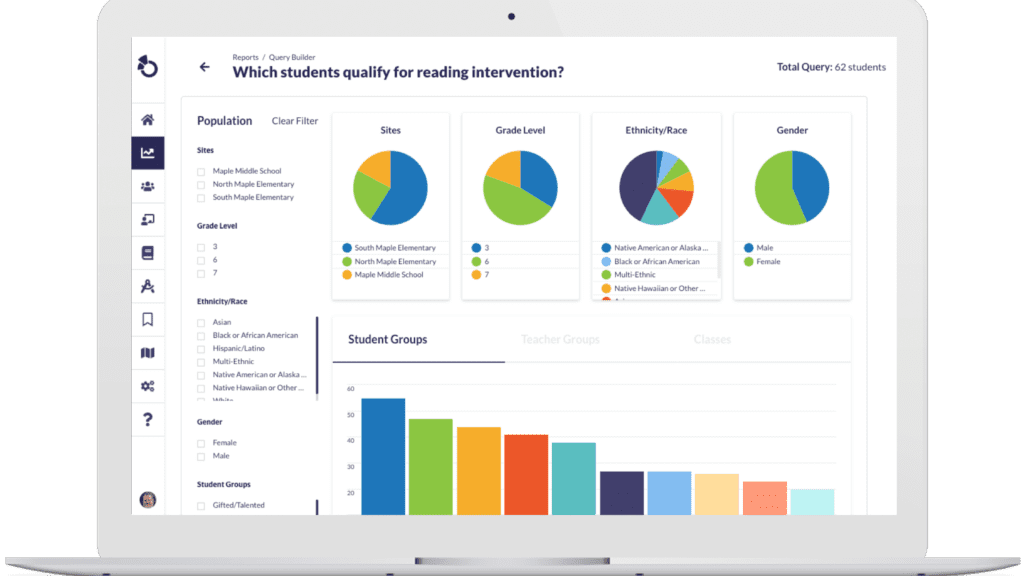Stop Guessing. Start Growing: Why Data is Massachusetts’ Strongest Asset for Student Success
By: David Specht
There’s no shortage of data in Massachusetts schools.
But let’s be honest – having data isn’t the same as using it well.
If disconnected spreadsheets and siloed systems are still powering your strategy, you’re not alone. However, you’re also not getting the full picture, and your students feel that gap.
To meet the goals set by the Department of Elementary and Secondary Education (DESE) – equity, student success, and data-informed instruction –you need more than reports.
You need clarity. Context. Action.
The data is there. So why isn’t it working?
Because when your data is fragmented, so is your strategy.
When systems don’t talk to each other, it’s more than just a tech issue; it’s a leadership challenge. You can’t support what you can’t see. And you can’t act quickly when you’re constantly stitching reports together.
Disconnected data creates barriers to:
- Spotting early warning signs
- Uncovering equity gaps
- Coordinating support across teams
What does this mean for your team?
Teachers make decisions based on partial information.
Leadership teams chase reports instead of driving instruction.
And your most vulnerable students? They fall through the cracks.
This isn’t just about tools or platforms.
It’s about confidence – in your insights, your response, and your ability to lead with clarity.
What happens when the pieces finally fit
 Successful districts aren’t just collecting data; they’re connecting it. And when that happens, everything changes: instruction sharpens, interventions happen faster, and students stop falling through the cracks.
Successful districts aren’t just collecting data; they’re connecting it. And when that happens, everything changes: instruction sharpens, interventions happen faster, and students stop falling through the cracks.
Here’s how two Massachusetts schools are making it a reality:
Marlborough Public Schools: Using data to advance equity
At Marlboro, over 60% of students speak a language other than English, so equity isn’t optional – it’s urgent.
Assistant Superintendent Jody O’Brien needed to understand which students were struggling and why. That meant more than running reports. It meant seeing across systems to identify patterns early and intervene with purpose.
“From an equity standpoint, I'm able to drill down and talk with administrators about any patterns, like, if there are higher percentages of special education students or students with low income who are also chronically absent. That's easy to look at within the Otus dashboard.”
Jody O’Brien
Assistant Superintendent
,
Marlborough Public Schools
With unified data in Otus, Marlborough leaders and educators can now:
- Track chronic absenteeism in real time
- Monitor subgroup trends and risk indicators
- Align interventions across student support teams
At Marlborough, educators and leaders are no longer reacting to issues.
They’re staying ahead of them.
New England Innovation Academy: Rethinking what ‘fair assessment’ really looks like
At New England Innovation Academy (NEIA), equity shows up in assessment.
Instead of averaging grades or rewarding box-checking, NEIA uses a competency-based grading model that focuses on skill mastery.
Translation? They’re giving every student a fair shot at success.
“Grades are based on competencies only and not on non-achievement factors like extra credit and compliance tasks. One of the things we’re always working on is to make sure the system is fair.”
Camp
Head of Teaching and Learning
,
New England Innovation Academy
By combining assessment, progress tracking, and feedback in Otus, NEIA can:
- Track individual student growth across disciplines
- Provide targeted, skill-specific feedback
- Use real-time data to guide instruction, not just evaluate it
It’s a system that works for students, not against them.
And it’s built on insights, not averages.
Want better outcomes? Start with better insights
 You don’t need another dashboard that shows you just one piece of the puzzle. You need a way to see the whole picture and, most importantly, act on it.
You don’t need another dashboard that shows you just one piece of the puzzle. You need a way to see the whole picture and, most importantly, act on it.
Otus doesn’t just display data – it connects it. It puts attendance, academics, behavior, assessments, and third-party scores in one place, so you spend less time chasing information and more time leading with it.
Because real progress only happens when:
- Insights are unified and easy to understand
- Everyone’s working from the same information
- Students get support before they fall behind
The future of education in Massachusetts will not be driven by disconnected tools and delayed decisions.
It will be led by the schools that know how to use data to move every learner forward.
And if that isn’t your school yet, now is the time to step up.
Request a demo!
See exactly how Otus can help your school accelerate student growth and improve student outcomes – all while saving educators time.





